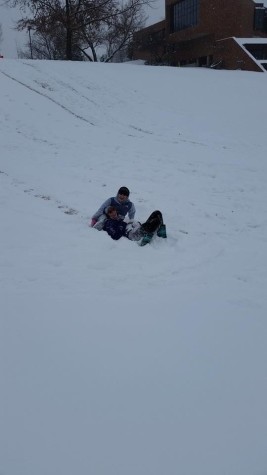The snow day: a thing of the past?
February 17, 2015
The icy wind whips through your hair as you fly down a snow covered hill; laughing as you plow into a powdery drift at the bottom. Then it happens: you feel a vibration in your back pocket. A notification has been sent that you have school work due and a sense of dread washes over you; your snow day is officially over.
With advancements in technology and the trend of online classes, traditional snow days are becoming a thing of the past. Today, students at IU Southeast came to terms with this reality.
Josie Garwood, Spanish freshman, realized her snow day was going to be much different than she had planned when she logged on to Canvas Monday morning.
“I thought I had a day off at first until I started seeing notifications from canvas informing me otherwise,” Garwood said.
Garwood is taking Social Problems with Veronica Medina, assistant professor of sociology. Medina has been prepared for the possibility of a snow day since the beginning of the semester.
She had students set up their Canvas accounts so that they would receive notifications through Facebook, Twitter or an alternate email account. Her students rarely miss an assignment because of this feature and were prepared when Medina assigned them a quiz on Monday morning.
“Since I had to move around some readings to reschedule the test, I wanted my students to demonstrate that they’d read the material that was due for today. I use Canvas and it makes conducting online quizzes really easy,” Medina said.
She also posted a digital lecture so that her class would not fall behind during the snow day, but recognizes that this is not a substitute for face-to-face lecturing.
“I think one major difference is the loss of interactivity. I encourage my students to ask questions or offer their observations during my lectures, which makes the material more clear and relevant,” Medina said. “If I do a recorded lecture or send PowerPoint slides, then students may lose that. Echo360 does allow students to post comments to recorded lectures– but we’re still on a learning curve with the technology.”

Jeremy Wells, assistant professor of English, said he agrees with Medina, believing that students lose the opportunity to be collaborative through classroom discussion.
Wells also created an assignment for his class to interact with during the snow day.
“Online work can help a class to maintain its momentum. I’ve used Canvas to invite my students in my Faulkner course to help me rewrite “Frosty the Snowman” in Faulkner’s style,” Wells said. “It’s silly, but it’s also a way of mastering Faulkner, making the great writer seem more familiar. This was an impromptu assignment I came up with soon after we learned that our class on Monday would be canceled.”
While Wells finds in class discussion important, he has also seen the benefits of online interaction this semester.
“I’m teaching my first online course this semester, and I find it remarkable how many students stay engaged and respond to a question I pose again and again. In a traditional classroom I’m generally pleased if I can two-thirds of the class to participate in a single discussion,” Wells said. “In the online classroom, I have might have 18 of 22 participating multiple times over a four-day discussion window. We lose spontaneity, but we do gain depth.”
Both professors understand that a snow day can be incredibly disruptive to class work, which is why they both decided to participate in online activities as opposed to taking the day off.
Medina believes snow days can make or break a class schedule which made the decision to assign online work an easy one; a decision Garwood is appreciative and understanding of.
“I really don’t mind having to do the work because I know that if we don’t do anything then we’ll be behind in the class. I’m appreciative because this way we are able to stay on task and I don’t have to drive to campus in the horrible conditions,” she said.


